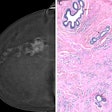SAN ANTONIO - Until the dust settles around the U.S. presidential election, a study to determine if full-field digital mammography fits into standard use may have to wait, according to Dr. Laurie Fajardo, professor of radiology at Johns Hopkins University School of Medicine in Baltimore.
Speaking during a plenary session last Saturday at the San Antonio Breast Cancer Symposium in San Antonio, Fajardo said an $18 million, 28,000-patient study is still awaiting approval from the National Institutes of Health.
"We have taken preliminary steps, but we are awaiting a budget. We have no budget because we have no president," she said. "So I'm not quite sure where the trial will go."
Fajardo said studies have yet to show major differences between the new technology and standard film-screen breast images that would justify the more expensive cost of digital mammography.
"Digital mammography makes prettier pictures," she said. "But it doesn't really show that radiologists can read them any better." Fajardo demonstrated that digital mammography could locate suspicious calcifications in portions of the breast that could not be seen on standard x-ray film because of fatty breasts or due to dense breast tissue.
However, Fajardo suggested that the new machines would have to be about three times as efficient as film-screen systems in order to be cost effective. "I don't think they will ever be more than twice as efficient," she said.
Studies comparing film-screen with digital mammography have found the machines to be comparable, and were sufficient to garner the Food and Drug Administration's approval of at least one full-field digital mammography product, Senographe 2000D from GE Medical Systems of Waukesha, WI. But the studies don’t make a convincing argument that digital is better, said Dr. Ray Lamb of the McLeod Cancer and Blood Center of Johnson City, TN.
"We are at the beginning of the story, not at the end," Lamb said. "We don't know yet what may be around the corner." He noted that the studies comparing digital mammography with standard mammography used selected patients, which might have biased the studies in favor of standard screening.
Fajardo said that digital mammograms have a number of potential advantages over film-screen:
- Improved contrast between dense and non-dense tissue.
- Disk storage reduces the likelihood of losing an original copy, and gives patients the opportunity to have their own copies.
- Near-real-time display of the digital image gives doctor and patient a chance to review the x-rays in the same visit.
- Computer-assisted interpretation is more feasible, since the image is already available for automatic assessment.
- Telemammography, or the ability to send the images electronically to remote locations, will facilitate second opinions.
Fajardo said digital mammography might be especially useful in young, high-risk patents whose dense breast tissue could result in an ambiguous standard mammogram. Digital mammography's better contrast properties might prove helpful in determining these patients' status, she said.
By Edward SusmanAuntMinnie.com contributing writer
December 13, 2000
Related Reading
Low reimbursement threatens breast imaging services, November 30, 2000
Full-field digital mammography compares well to screen-film, November 27, 2000
Task, lesion type make a difference in digital mammography display, August 31, 2000
Instrumentarium to debut Diamond system in step towards full-field digital mammo, April 7, 2000
Digital mammography to face tough implementation hurdles, February 7, 2000
FDA approves GE's full-field digital mammography system, January 31, 2000
Click here to post your comments about this story. Please include the headline of the article in your message.
Copyright © 2000 AuntMinnie.com



















